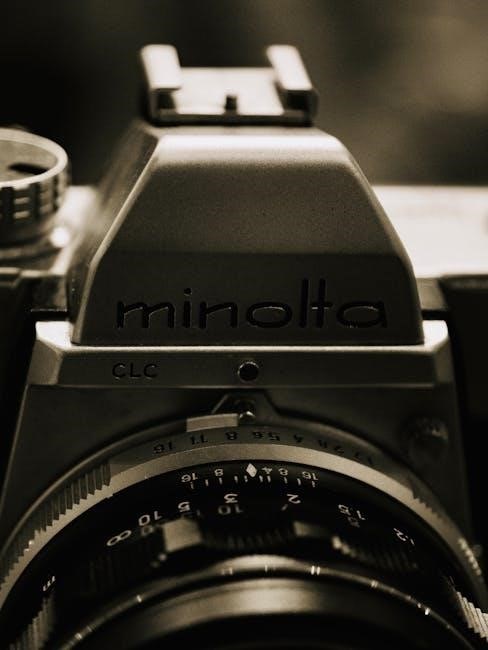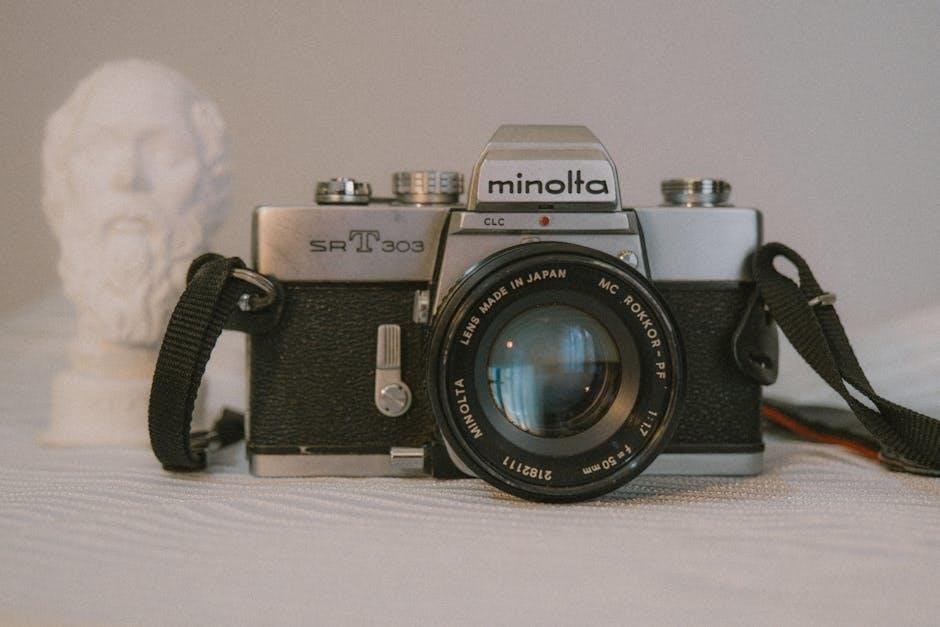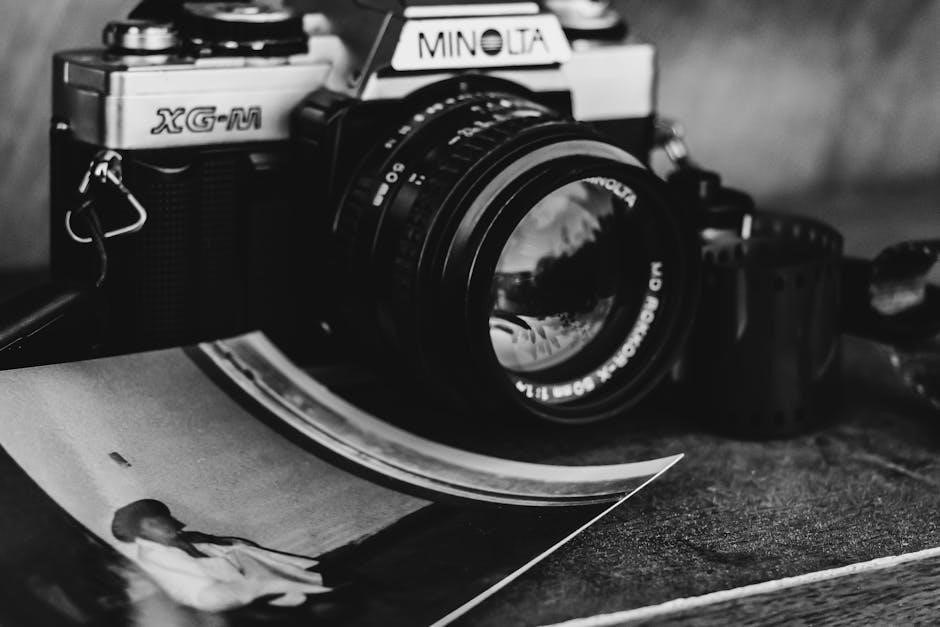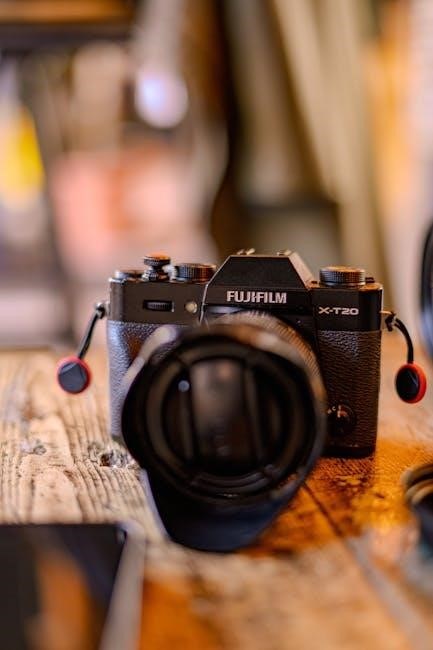Minolta X-700 Manual: A Comprehensive Guide
Welcome to a comprehensive exploration of the Minolta X-700! This guide aims to unlock the full potential of this state-of-the-art SLR camera, central to the Minolta Program System. We will cover everything to ensure a smooth, rewarding experience.
The Minolta X-700, introduced in 1981, stands as a landmark in 35mm SLR photography, embodying a blend of accessibility and advanced features. As the flagship model of Minolta’s final manual-focus SLR series, it gained immense popularity for its user-friendly design and innovative programmed auto-exposure (AE) control. This camera simplified the photographic process, making it appealing to both beginners and experienced photographers.
Its focus-and-shoot simplicity, coupled with the ability to manually adjust settings, offered a versatile shooting experience. The X-700’s widespread appeal cemented its place in photographic history, attracting those seeking a balance between automation and creative control. Its enduring legacy is a testament to its innovative design and user-centric features.

This comprehensive guide delves into the various aspects of the Minolta X-700, covering its key features, functionalities, and maintenance tips. Whether you’re a novice or a seasoned photographer, this guide will provide valuable insights into maximizing the potential of this classic camera. Get ready to embark on a journey to master the Minolta X-700 and capture stunning images with ease.
Key Features and Functions
The Minolta X-700 boasts a range of key features that contributed to its popularity. At its core lies the programmed auto-exposure (AE) mode, which automatically sets both aperture and shutter speed, ensuring proper exposure in various lighting conditions. This feature simplifies the shooting process, allowing photographers to concentrate on composition and capturing the moment.

Beyond programmed AE, the X-700 offers aperture priority AE, giving users control over depth of field while the camera selects the appropriate shutter speed. For full creative control, the manual mode allows independent adjustment of both aperture and shutter speed. The viewfinder provides continuous LED readout of shutter speeds, aiding in precise exposure adjustments.
Other notable features include a bright viewfinder for easy focusing, exposure compensation for fine-tuning brightness, and compatibility with a wide range of Minolta lenses and accessories. The X-700 also features an audible beep to alert users of potential blurring due to slow shutter speeds, preventing blurry images. These features combine to make the X-700 a versatile and user-friendly camera.
Loading Film into the X-700
Loading film into your Minolta X-700 is a straightforward process. Begin by gently pulling out the film rewind crank located on the left side of the camera top plate. This action will release the back cover, allowing you to swing it open. Insert your chosen 35mm film cartridge into the film chamber, ensuring that the cartridge is seated securely.
Next, draw the film leader across the camera back and insert it into one of the slots in the take-up spool. Advance the film using the film advance lever on the right side of the camera. Continue advancing the film until the sprocket holes on the film engage with the teeth on the film transport sprocket.
Close the camera back, ensuring that it clicks securely shut. Continue advancing the film lever two or three times, firing the shutter each time, until the frame counter displays ‘1’. Now your X-700 is ready to capture your photographic vision. Be mindful to only open the back cover in subdued lighting to prevent exposing the film.
Understanding the Viewfinder
The viewfinder of the Minolta X-700 offers a wealth of information, essential for achieving well-exposed and sharp images. At the center, you’ll find the focusing screen, often featuring a split-image rangefinder surrounded by a microprism collar. These aids assist in achieving precise focus, ensuring your subject is sharp.
Along the right side of the viewfinder, you’ll see a vertical LED display. This display provides real-time information about the shutter speed selected by the camera in Program AE or Aperture Priority AE modes. In manual mode, it indicates the suggested shutter speed based on the camera’s metering, allowing you to adjust accordingly.
Additionally, the viewfinder displays a ‘+’, ‘0’, and ‘-‘ to indicate overexposure, correct exposure, and underexposure, respectively. Pay close attention to these indicators to make informed decisions about your exposure settings. Becoming familiar with these elements will greatly enhance your control and creative possibilities with the X-700.
Exposure Modes: Program AE (P), Aperture Priority AE (A), and Manual
The Minolta X-700 offers three distinct exposure modes, each providing a different level of control over your photography. Program AE (P) mode is designed for simplicity and ease of use. The camera automatically selects both the aperture and shutter speed, making it ideal for beginners or situations where speed is essential.
Aperture Priority AE (A) mode allows you to select the aperture, controlling the depth of field, while the camera automatically sets the appropriate shutter speed. This mode is perfect for portraits or landscapes where depth of field is a critical element.
Finally, Manual mode gives you complete control over both aperture and shutter speed. This is best suited for experienced photographers who want to fine-tune their exposure settings for creative effects or challenging lighting conditions. Understanding and mastering these modes unlocks the full creative potential of the X-700.
Using the Programmed Auto-Exposure (AE) Mode
The Programmed Auto-Exposure (AE) mode, often denoted as “P” on the Minolta X-700, is your gateway to effortless photography. It’s designed for scenarios where capturing the moment quickly takes precedence over manual adjustments. To engage this mode, simply set the mode dial to “P.” The camera then intelligently selects both the aperture and shutter speed based on the available light, ensuring optimal exposure.
The viewfinder displays the selected shutter speed, allowing you to monitor the camera’s decision. In dim lighting, the camera prioritizes faster shutter speeds to prevent blur. If desired, an audible beep can be enabled to alert you when the shutter speed drops below a certain threshold, indicating a potential risk of camera shake. Program mode is a great way to start.
Aperture Priority AE Mode Explained
Aperture Priority AE (A) mode grants you creative control over depth of field while still leveraging the camera’s automatic exposure capabilities. In this mode, you select the desired aperture, and the X-700 automatically sets the corresponding shutter speed to achieve proper exposure.
This mode is ideal for portraits, landscapes, and situations where controlling the area of sharpness is crucial. A wider aperture (smaller f-number) creates a shallow depth of field, blurring the background and isolating the subject. Conversely, a smaller aperture (larger f-number) yields a greater depth of field, ensuring sharpness from foreground to background. In the viewfinder, you’ll see the selected aperture and the automatically determined shutter speed. This mode gives you flexibility while maintaining proper exposure.
Full Manual Mode Operation
For complete creative flexibility, the Minolta X-700 offers a full manual (M) mode, allowing you to independently set both the aperture and shutter speed. This mode is essential for challenging lighting situations or when you desire precise control over the final image.
To operate in manual mode, first, set the mode dial to “M”. Then, select your desired aperture using the aperture ring on the lens and the shutter speed using the shutter speed dial on the camera body; Use the camera’s light meter, visible in the viewfinder, to determine the correct exposure settings. Adjust the aperture and shutter speed until the meter indicates a balanced exposure. The meter displays a “+” sign when overexposed, a “-” sign when underexposed, and a “0” when correctly exposed.
Lens Care and Maintenance
Proper care and maintenance of your Minolta X-700 lenses are crucial for ensuring optimal image quality and longevity. Always handle lenses with care, avoiding impacts and sudden temperature changes. Store lenses in a cool, dry place, preferably in a lens case, to protect them from dust, moisture, and direct sunlight.
To clean your lenses, use a soft, lint-free microfiber cloth specifically designed for lens cleaning; Gently wipe the lens surface in a circular motion, starting from the center and moving outwards. For stubborn smudges or fingerprints, use a small amount of lens cleaning solution applied to the cloth, never directly to the lens. Avoid using excessive pressure or harsh chemicals, as they can damage the lens coating.

Regularly inspect your lenses for dust, fungus, or scratches. If you notice any of these issues, consult a qualified camera repair technician. Proper lens care will ensure that your Minolta X-700 lenses continue to deliver sharp, clear images for years to come.
Troubleshooting Common Issues
Even with proper care, you might encounter issues with your Minolta X-700. A common problem is a malfunctioning meter, indicated by incorrect exposure readings. Ensure the batteries are fresh and properly installed. Clean the battery contacts with a dry cloth if necessary. If the meter still doesn’t work, a professional repair may be needed.
Another issue is film advance problems. If the film doesn’t advance smoothly, check that the film is loaded correctly and that the rewind crank is properly engaged. Avoid forcing the film advance lever, as this can damage the mechanism.
If you experience blurry images, ensure that your shutter speed is appropriate for the shooting conditions. Use a faster shutter speed or a tripod to prevent camera shake. Also, check the lens for cleanliness and proper focus.
For any persistent issues, consult the official Minolta X-700 instruction manual or seek assistance from a qualified camera technician.
Accessories and Compatibility
The Minolta X-700 is compatible with a wide range of accessories, enhancing its versatility. Minolta offered various lenses within the MD mount system, providing options for wide-angle, telephoto, and macro photography. These lenses ensure excellent image quality and seamless integration with the camera’s metering system.
Flash units designed for the Minolta system, such as the Minolta Auto Electroflash series, offer TTL (Through-The-Lens) flash metering for accurate and automatic flash exposure. Using compatible flash units ensures proper synchronization and simplifies flash photography.
Motor drives, like the Minolta Motor Drive 1, can be attached to the X-700, enabling continuous shooting at up to 3.5 frames per second. This is particularly useful for capturing action sequences or fast-moving subjects.

Other accessories include filters, lens hoods, and remote shutter releases, further expanding the creative possibilities of the Minolta X-700. Be sure to verify compatibility before purchasing accessories to ensure proper functionality.
